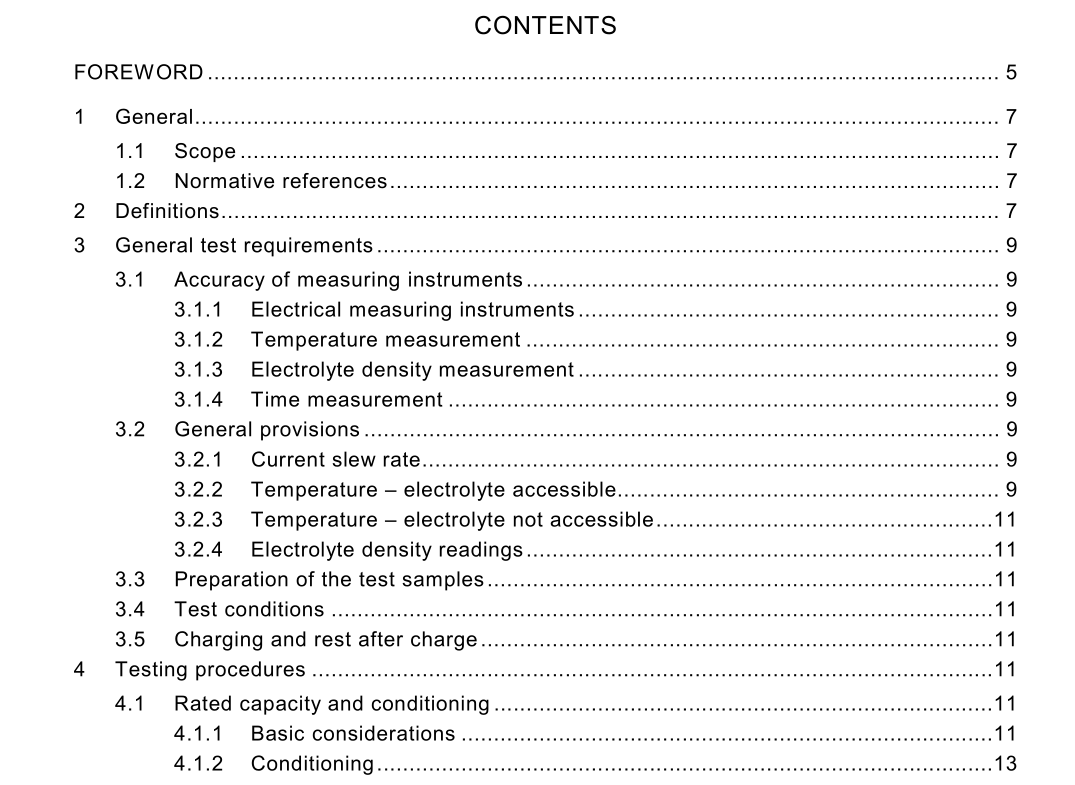IEC 61982-2 pdf download

IEC 61982-2 pdf download.Secondary batteries for the propulsion of electric road vehicles
3 General test requirements
3.1 Accuracy of measuring instruments 3.1.1 Electrical measuring instruments 3.1.1.1 Range of measuring devices The instruments used shall enable the values of voltage and current to be correctly measured. The range of these instruments and measuring methods shall be chosen so as to ensure the accuracy specified for each test. For analogue instruments, this implies that the readings shall be taken in the last third of the graduated scale. Any other measuring instruments may be used provided they give an equivalent accuracy. 3.1.1.2 Voltage measurement The instruments used for voltage measurement shall be voltmeters of an accuracy class equal to 0,5 or better. The resistance of the voltmeters used shall be at least 1 000 Ω/V (see IEC 60051 or IEC 60485). 3.1.1.3 Current measurement The instruments used for current measurement shall be ammeters of an accuracy class equal to 0,5 or better. The entire assembly of ammeter, shunt and leads shall be of an accuracy class of 0,5 or better (see IEC 60051 or refer to IEC 60359). 3.1.2 Temperature measurement The temperature measuring instruments shall have a suitable range in which the value of each graduated division is not in excess of 1 K. The absolute accuracy of the instrument shall be at least 0,5 K. 3.1.3 Electrolyte density measurement For measuring electrolyte densities, hydrometers shall be used with scales so graduated, that the value of each division is not in excess of 5 kg/m 3 . The absolute accuracy of the instrument shall be at least 5 kg/m 3 . 3.1.4 Time measurement The instruments used for measuring time shall have an accuracy of ±1 % or better. NOTE Any instrument may be used on condition that the accuracy requirements of 3.1 are maintained. 3.2 General provisions 3.2.1 Current slew rate The current slew rate during the dynamic tests shall be ≤1 s from one steady state to the next. 3.2.3 Temperature – electrolyte not accessible The cell temperature shall be measured by use of a surface temperature-measuring device. The temperature shall be measured at a location, which most closely reflects the electrolyte temperature. 3.2.4 Electrolyte density readings Because of the varying rates of stabilization of cells, electrolyte density readings shall be taken at times most appropriate to the test sample but within the constraints of the test regime. 3.3 Preparation of the test samples Cells constituting the test unit and subjected to a dynamic discharge performance test or a dynamic endurance test shall previously have achieved an actual capacity at least equal to the rated capacity. 3.4 Test conditions The dynamic endurance test shall be carried out with the test unit, preferably partially immersed in an oil or water bath. The temperature shall be kept within the value defined for the test ±2 °C and circulation within the bath shall allow for efficient cooling of the cells. Test temperatures are specified in annex A. Where physical constraints prevent the use of liquid coolants, air-cooling may be used. In this case, and for batteries with an integrated thermal management system, the same test conditions as in liquid thermal management shall be applied. During the test, if applicable and necessary, the electrolyte level shall be kept within the limits recommended by the manufacturer. 3.5 Charging and rest after charge The cells shall be charged in accordance with a charging procedure specified by the manu- facturer and within the limits in this standard prior to the discharge test. After charging, the test sample shall be stored for 1 h to 4 h at the test ambient temperature declared for the test to be performed.
4.2 Dynamic discharge performance test
4.2.1 Basic considerations The objective of this test is to specify the conditions to derive a value for the battery capacity which is closely related to the available capacity in an electric road vehicle application. In electric vehicle applications, propulsion batteries shall be capable of supplying widely varying current rates. The driving profiles can be simplified to high-rate current for acceleration, low-rate current for constant speed driving and zero current for rest periods. When considering battery recharging during vehicle braking (regenerative charging), a high- rate recharge pulse is incorporated in the test profile.









